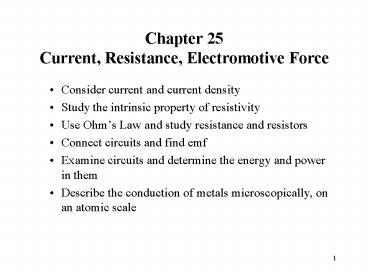Chapter 25 Current, Resistance, Electromotive Force PowerPoint PPT Presentation
1 / 26
Title: Chapter 25 Current, Resistance, Electromotive Force
1
Chapter 25Current, Resistance, Electromotive
Force
- Consider current and current density
- Study the intrinsic property of resistivity
- Use Ohms Law and study resistance and resistors
- Connect circuits and find emf
- Examine circuits and determine the energy and
power in them - Describe the conduction of metals
microscopically, on an atomic scale
2
The direction of current flow
- In the absence of an external field, electrons
move randomly in a conductor. If a field exists
near the conductor, its force on the electron
imposes a drift.
-The electrons move at a random velocity and
collide with stationary ions. Velocity in the
order of 106 m/s -Drift velocity is
approximately 10-4 m/s
3
Current flowing
- Positive charges would move with the electric
field, electrons move in opposition. - The motion of electrons in a wire is analogous to
water coursingthrough a river.
4
Electric Current
Electrical current (I) in amperes is defined as
the rate of electric charge flow in coulombs per
second. 1 ampere (A) of current is a rate of
charge flow of 1 coulomb/second.
1 mA (milliampere) 1 x 10-3 A (ampere)
(25-1)
1 ?A(microampere) 1 x 10-6 A (ampere)
Conventional Current Direction
5
Electric Current Density
Current, Drift Velocity, and Current Density
where n charge carriers per unit volume
q charge per charge carrier in coulombs
vd average drift velocity of charge
carriers in
meters per second
amperes
current density in amperes/m2
6
Resistivity
Drift Velocity
where ? mobility of conducting material Drift
Velocity is 1010 slower than Random Velocity
Definition of resistivity in ohm-meters (?-m).
where
conductivity of the material.
Resistivity of the material.
7
Resistivity is intrinsic to a metal sample (like
density is)
8
Resistivity and Temperature
- In metals, increasing temperature increases ion
vibration amplitudes, increasing collisions and
reducing current flow. This produces a positive
temperature coefficient. - In semiconductors, increasing temperature shakes
loose more electrons, increasing mobility and
increasing current flow. This produces a negative
temperature coefficient. - Superconductors, behave like metals until a phase
transition temperature is reached. At lower
temperatures R0.
9
Resistance Defined
for a uniform E
Solve for V
Ohms Law
therefore
where R is the resistance of the material in ohms
(?)
10
Ohms law an idealized model
- If current density J is nearly proportional to
electric field E ratio E/J constant and
Ohms law applies V I R - Ohms Law is linear, but current flow through
other devices may not be.
Linear
Nonlinear
Nonlinear
Ohms law applies
11
Resistors are color-coded for assembly work
Examples Brown-Black-Red-Gold 1000 ohms
5 to -5 Yellow-Violet-Orange-Silver 47000
ohms 10 to -10
12
Electromotive force and circuits
- If an electric field is produced in a conductor
without a complete circuit, current flows for
only a very short time. - An external source is needed to produce a net
electric field in a conductor. This source is an
electromotive force, emf , ee-em-eff, (1V 1
J/C)
13
Ideal diagrams of open and complete circuits
14
Symbols for circuit diagrams
- Shorthand symbols are in use for all wiring
components
15
Electromotive Force and Circuits
Electromotive Force (EMF)
Ideal Source
I
Complete path needed for current (I) to flow
Voltage rise in current direction
VR
Voltage drop in current direction
Ideal source of electrical energy
VR EMF R I
Real Source
I
a
External resistance
Internal source resistance
Vab
Real source of electrical energy
b
16
A Source with an Open Circuit
Example 25-5
I 0 amps
Figure 25-16
17
A source in a complete circuit
Example 25-6
Figure 25-17
18
A Source with a Short Circuit
Example 25-8
I 6 A
Figure 25-19
19
Potential Rises and Drops in a Circuit
Figure 25-21
20
Energy and Power
Defined
Substitute for
Divide by
watts
Pure Resistance
1 watt 1 joule/sec
21
Power Output of an EMF Source
I
a
Vab
b
Power output of battery
Power dissipated in R
Power dissipated in battery resistance
Power supplied by the battery
22
Power Input to a Source
I
a
Vab greater then the EMF of the battery
b
Power dissipated in battery resistance
Power charging the battery
Total Power input to battery
23
Power Input and Output in a Complete Circuit
Example 25-9
Figure 25-25
24
Power in a Short Circuit
Example 25-11
25
Theory of Metallic Conduction
- Simple, non-quantum-mechanical model
- Each atom in a metal crystal gives up one or
more electrons that are free to move in the
crystal. - The electrons move at a random velocity and
collide with stationary ions. Velocity in the
order of 106 m/s (drift velocity is approximately
10-4 m/s) - The average time between collisions is the mean
free time, t. - As temperature increases the ions vibrate more
and produce more collisions, reducing t.
26
A microscopic look at conduction
- Consider Figure 25.27.
- Consider Figure 25.28.
- Follow Example 25.12.

